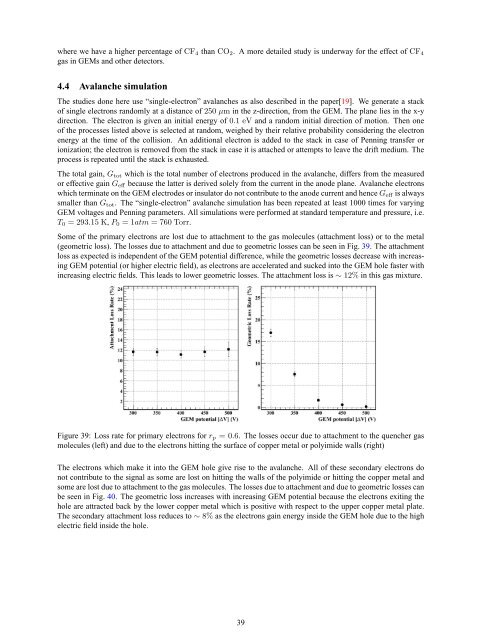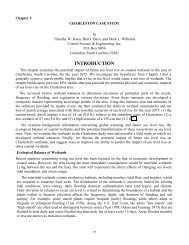A GEM Detector System for an Upgrade of the CMS Muon Endcaps
A GEM Detector System for an Upgrade of the CMS Muon Endcaps
A GEM Detector System for an Upgrade of the CMS Muon Endcaps
You also want an ePaper? Increase the reach of your titles
YUMPU automatically turns print PDFs into web optimized ePapers that Google loves.
where we have a higher percentage <strong>of</strong> CF4 th<strong>an</strong> CO2. A more detailed study is underway <strong>for</strong> <strong>the</strong> effect <strong>of</strong> CF4<br />
gas in <strong>GEM</strong>s <strong>an</strong>d o<strong>the</strong>r detectors.<br />
4.4 Aval<strong>an</strong>che simulation<br />
The studies done here use “single-electron” aval<strong>an</strong>ches as also described in <strong>the</strong> paper[19]. We generate a stack<br />
<strong>of</strong> single electrons r<strong>an</strong>domly at a dist<strong>an</strong>ce <strong>of</strong> 250 µm in <strong>the</strong> z-direction, from <strong>the</strong> <strong>GEM</strong>. The pl<strong>an</strong>e lies in <strong>the</strong> x-y<br />
direction. The electron is given <strong>an</strong> initial energy <strong>of</strong> 0.1 eV <strong>an</strong>d a r<strong>an</strong>dom initial direction <strong>of</strong> motion. Then one<br />
<strong>of</strong> <strong>the</strong> processes listed above is selected at r<strong>an</strong>dom, weighed by <strong>the</strong>ir relative probability considering <strong>the</strong> electron<br />
energy at <strong>the</strong> time <strong>of</strong> <strong>the</strong> collision. An additional electron is added to <strong>the</strong> stack in case <strong>of</strong> Penning tr<strong>an</strong>sfer or<br />
ionization; <strong>the</strong> electron is removed from <strong>the</strong> stack in case it is attached or attempts to leave <strong>the</strong> drift medium. The<br />
process is repeated until <strong>the</strong> stack is exhausted.<br />
The total gain, Gtot which is <strong>the</strong> total number <strong>of</strong> electrons produced in <strong>the</strong> aval<strong>an</strong>che, differs from <strong>the</strong> measured<br />
or effective gain Geff because <strong>the</strong> latter is derived solely from <strong>the</strong> current in <strong>the</strong> <strong>an</strong>ode pl<strong>an</strong>e. Aval<strong>an</strong>che electrons<br />
which terminate on <strong>the</strong> <strong>GEM</strong> electrodes or insulator do not contribute to <strong>the</strong> <strong>an</strong>ode current <strong>an</strong>d henceGeff is always<br />
smaller th<strong>an</strong> Gtot. The “single-electron” aval<strong>an</strong>che simulation has been repeated at least 1000 times <strong>for</strong> varying<br />
<strong>GEM</strong> voltages <strong>an</strong>d Penning parameters. All simulations were per<strong>for</strong>med at st<strong>an</strong>dard temperature <strong>an</strong>d pressure, i.e.<br />
T0 = 293.15 K, P0 = 1atm = 760 Torr.<br />
Some <strong>of</strong> <strong>the</strong> primary electrons are lost due to attachment to <strong>the</strong> gas molecules (attachment loss) or to <strong>the</strong> metal<br />
(geometric loss). The losses due to attachment <strong>an</strong>d due to geometric losses c<strong>an</strong> be seen in Fig. 39. The attachment<br />
loss as expected is independent <strong>of</strong> <strong>the</strong> <strong>GEM</strong> potential difference, while <strong>the</strong> geometric losses decrease with increasing<br />
<strong>GEM</strong> potential (or higher electric field), as electrons are accelerated <strong>an</strong>d sucked into <strong>the</strong> <strong>GEM</strong> hole faster with<br />
increasing electric fields. This leads to lower geometric losses. The attachment loss is∼ 12% in this gas mixture.<br />
Figure 39: Loss rate <strong>for</strong> primary electrons <strong>for</strong> rp = 0.6. The losses occur due to attachment to <strong>the</strong> quencher gas<br />
molecules (left) <strong>an</strong>d due to <strong>the</strong> electrons hitting <strong>the</strong> surface <strong>of</strong> copper metal or polyimide walls (right)<br />
The electrons which make it into <strong>the</strong> <strong>GEM</strong> hole give rise to <strong>the</strong> aval<strong>an</strong>che. All <strong>of</strong> <strong>the</strong>se secondary electrons do<br />
not contribute to <strong>the</strong> signal as some are lost on hitting <strong>the</strong> walls <strong>of</strong> <strong>the</strong> polyimide or hitting <strong>the</strong> copper metal <strong>an</strong>d<br />
some are lost due to attachment to <strong>the</strong> gas molecules. The losses due to attachment <strong>an</strong>d due to geometric losses c<strong>an</strong><br />
be seen in Fig. 40. The geometric loss increases with increasing <strong>GEM</strong> potential because <strong>the</strong> electrons exiting <strong>the</strong><br />
hole are attracted back by <strong>the</strong> lower copper metal which is positive with respect to <strong>the</strong> upper copper metal plate.<br />
The secondary attachment loss reduces to ∼ 8% as <strong>the</strong> electrons gain energy inside <strong>the</strong> <strong>GEM</strong> hole due to <strong>the</strong> high<br />
electric field inside <strong>the</strong> hole.<br />
39
















